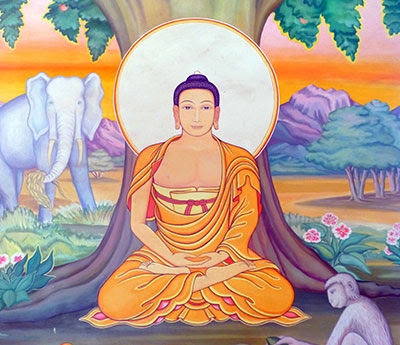 |
| Trees are conscious. I just know it. |
%20from%20Kedah,%20Malaysia%20by%20Sado,%20Thailand%20WIKI.jpg) |
| Then Sujata saved the Bodhisattva with food. |
 |
| Dryads are spirits in trees. |
Though purists in the tradition say the Bodhisattva, living on his own in the forest by his own rules or those generally adhered to by independent wandering ascetics, was fasting all that time, and no one seems to know how long from the time the Bodhisattva left the lifesaving donor Sujata and her maid, who nursed him back to health from his previous extreme fasting.
- Plants are too incredible: There's a tree that walks?! It's known as the "Walking Palm" (Socratea exorrhiza and Socratea exorrhiza) of Central and South America. Where is it going as it moves 20 feet per year?
With Bodhi trees everywhere in the world now, most of them directly related to that very tree, Bo, the oldest documented tree in the world, now living on the Buddhist and Hindu island of Sri Lanka, most Buddhists never seem to think to eat the fruit. It falls to the ground and is squashed underfoot during sacred circumambulations or disregarded. Asking Theravada Buddhist monks about it, they laughed off the question. A little research revealed that in India the sacred fig is regarded as a famine food so is not usually eaten, probably due to its small size. But what an idea -- Buddhist Fig Newtons with gluten free crust. They're delicious and easy to collect, more easily with a net to catch them as they fall before the ants find them.
 India is amazing for its trees. At least three should be sacred to Buddhists, more sacred than all tree already are. They are the sacred fig, the sal tree (which helped the Buddha a great deal, first sheltering him until Sujata found him and gave him her dana or charity and the twin sals the Buddha chose for his final nirvana), and sandalwood which provides incense around the world and is nearly being brought to extinction because of its healing scent.
India is amazing for its trees. At least three should be sacred to Buddhists, more sacred than all tree already are. They are the sacred fig, the sal tree (which helped the Buddha a great deal, first sheltering him until Sujata found him and gave him her dana or charity and the twin sals the Buddha chose for his final nirvana), and sandalwood which provides incense around the world and is nearly being brought to extinction because of its healing scent.Everywhere in India there is a healing tree, the "village pharmacy" known as the neem tree (as valuable a medicine as the moringa or drumstick tree is nutritious). But even more valuable might be the incredible coconut tree, a source of food, fiber, fuel, oil, sugar, pure water, so valuable that in ancient times to cut one down was considered tantamount to killing a person.
 |
| Pongamia in Oahu, Hawaii, USA |
This tree is incredible for its potential as a biofuel, being 30% oil (in the bean it produces), and nutrient dense due to its high protein content (65% to 70% high quality protein). It is a plant-based oil and a food, a plant that restores oxygen to the environment as well as providing sustenance to bees, the soil, microorganisms like the mycorrhizae (fungi, mycelia) in the ground, and all the other benefit trees provide this world.
- Dhr. Seven, Amber Larson, Pat Macpherson, Wisdom Quarterly; MSN.com


_near_Hyderabad_W_IMG_7633,%20Karangh,%20Indian%20Beech%20Tree,%20honge%20Tree,%20Pongam%20Tree,%20Panigrahi%20at%20Deer%20Park%20in%20Shamirpet,%20Rangareddy%20district,%20Andra%20Pradesh,%20India.jpg)

No comments:
Post a Comment